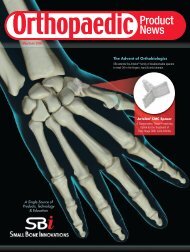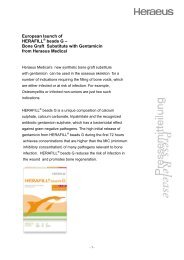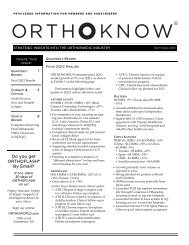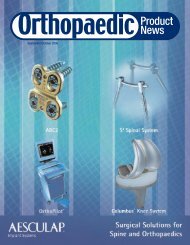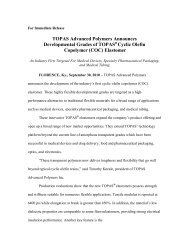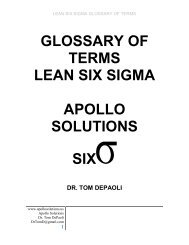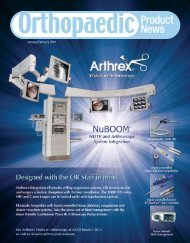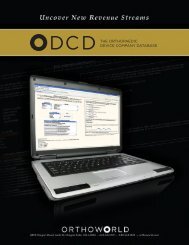FUTURETECHcontinued from page 37Table 2: Data collection grid for knee arthroplasty studyRotator Cuff RepairCurrent controversies are by no means confined to arthroplasty.Rotator cuff repair is also a rapidly growing, rapidlychanging procedure that is the subject of opposing viewpointsarmed with little clinical evidence. Rotator cuff tears are the mostcommon source of shoulder pain and disability 13 and rotator cuffsurgery is intended to alleviate pain and improve shoulderfunction in the wake of these tears. Over the years, the surgeryhas evolved from open procedures, mini-open proceduresassisted by arthroscopy and full arthroscopic procedures. Mostrecently, a controversy has developed around the clinical benefitsof arthroscopically assisted mini-open procedures vs. full arthroscopicprocedures.The mini-open technique uses a four to six centimeter incisionand a unique set of arthroscopic-assisted instruments to performthe repair. The relative benefit of using this procedure instead ofthe full arthroscopic technique is that it allows for bettertransosseous fixation and footprint restoration. This enables theapplication of stronger, modified stitching techniques, such as theMason-Allen stitch. The disadvantages of this technique includereports of increased stiffness, less range of motion, higherinfection risk and increased prevalence of arthrofibrosis. 14 The fullarthroscopic technique uses a fiber optic scope and pencil-sizedinstruments inserted through a small incision. This minimallyinvasive procedure is reportedly associated with less pain, rapidrehabilitation, smaller incisions, less soft tissue dissection andlow risk of deltoid detachment. 14 In some cases, there can also bebetter three-dimensional visualization. Full arthroscopic cufffixation is obtained with suture anchors, which are reported tohave weaker fixation strength than transosseous tunnels. Also,the procedure is technically demanding, and typically onlyavailable at high-volume practices. 14Nho et al. 14 stated that there is a “need for an improvement inquality in published studies on rotator cuff repair.” Two recentmeta-analyses found only Level III retrospective case controlstudies, 14,15 and were unable to discern a clinical differencebetween the two methods. Other aspects of the surgery have notbeen fully evaluated using clinical outcomes. For example, moststudies of arthroscopic outcomes have used single-row anchorfixationconfiguration, while a double-row version has beenshown to better replicate the native footprint. 15 Lastly, the clinicaleffect of footprint restoration is not yet fully understood. 15Ideally, a multi-center randomized control trial would includevalidated outcomes scores and post-operative imaging. Collectedoutcomes would include complications, range of motion, pain,patient and surgeon satisfaction, quality of life (SF-36, SF-12),functioning (American Shoulder and Elbow Surgeons, DisabilityArm Shoulder Hand Score, Western Ontario Rotator Cuff) andpost-operative radiographs. The current lack of post-operativeradiographic assessment leaves a gap of understanding on theradiographic integrity of any repair. An appropriate time framefor the study would be from two to five years, in order to assesslonger term follow-up. Participating centers should have significantexperience with both procedures. As outcomes have beenreported to be highly dependent on the pre-operative tear size, 16this variable should be measured and controlled. Table 3 shows apotential data collection grid for this type of study.ConclusionLike Kyphon, medical device entrepreneurs can givethemselves a significant market advantage by supporting highqualitypost-market clinical research for their most innovativeproducts and procedures. Ironically, there is a dearth of suchstudies in the largest, fastest growing orthopaedic markets,despite controversies surrounding a number of emergingtechnologies. These controversies provide an opportunity forentrepreneurs to show the worth of their innovations throughcontinued on page 3938 ORTHOPAEDIC PRODUCT NEWS • November/December 2009
FUTURETECHcontinued from page 38Table 3: Data collection grid for rotator cuff repair studyhigh-quality randomized post-market trials while cementingstrong relationships with forward thinking, like-mindedsurgeons.While this article discusses the gap in high quality clinicalresearch in just a few markets, this distressing trend is notisolated to hip resurfacing, minimally invasive knee arthroplastyand rotator cuff repair. For example, a recent systematic review ofthe literature reporting outcomes of total ankle arthroplastyfound only Level IV evidence studies. 17 Until use of high-qualitytrials for new products becomes standard practice, skepticismamong clinicians will persist and market adoption of new ideaswill be slow.References1. “Globus Breaks Sales Performance Record: $0 to >$80MM in Less than 3 1/2Years,” ORTHOKNOW®, February 2007, pp. 4.2. Lieberman, I.H., Dudeney, S., Reinhardt, M.-K., Bell, G., 2001, “Initial outcomeand efficacy of ‘Kyphoplasty’ in the treatment of painful osteoporotic vertebralcompression fractures,” Spine, 26: 1631-1638.3. Ohlin, A., Johnell, O., 2004, “Vertebroplasty and kyphoplasty in the fracturedosteoporotic spine,” Clin Calcium, 14: 65-69.4. Grafe, I.A., Da Fonseca, K., Hillmeier, J., Meeder, P.J., Libicher, M., Noldge, G.,Bardenheuer, H., Pyerin, W., Basler, L., Weiss, C., Taylor, R.S., Nawroth, P.,Kasperk, C., 2005, “Reduction of pain and fracture incidence afterkyphoplasty: 1-year outcomes of a prospective controlled trial of patients withprimary osteoporosis,” Ostoporosis Int, 16: 2005-2012.5. Kurtz, S., Ong, K., Lau, E., Mowat, F., Halpern, M., 2007, “Projections ofprimary and revision hip and knee arthroplasty in the United States from 2005to 2030,” J Bone Joint Surg Am, 89:780-785.6. Grigoris, P., Roberts, P., Panousis, K., Bosch, H., 2005, “The evolution of hipresurfacing arthroplasty,” Orthop Clin N Am, 36: 125-134.7. McGrath, M.S., Desser, D.R., Ulrich, S.D., Seyler, T.M., Marker, D.R., Mont,M.A., 2008, “Total hip resurfacing in patients who are sixty years of age orolder,” J Bone Joint Surg Am, 90: 27-31.8. Nunley, R.M., Della Valle, C.J., Barrack, R.L., 2009, “Is patient selectionimportant for hip resurfacing?” Clin Orthop Relat Res, 467: 56-65.9. Huo, M.H., Parvizi, J., Bal, B.S., Mont, M.A., 2008, “What’s new in total hiparthroplasty,” J Bone Joint Surg Am, 90: 2043-2055.10. Ulrich, S.D., Mont, M.A., Bonutti, P.M., Seyler, T.M., Marker, D.R., Jones, L.C.,2007, “Scientific evidence supporting computer-assisted surgery andminimally invasive surgery for total knee arthroplasty,” Exp Rev Med Dev, 4:497-505.11. Dutton, A.Q., Yeo, S., Yang, K., Lo, N., Chia, K., Chong, H., 2008,“Computer-assisted minimally invasive total knee arthroplasty comparedwith standard total knee arthroplasty. A prospective, randomized study.” JBone Joint Surg Am, 90: 2-9.12. Borus, T., Thornhill, T., 2008, “Unicompartmental knee arthroplasty,” J AmAcad Orthop Surg, 16: 9-18.13. MacDermaid, J.C., Holtby, R., Razmjou, H., Bryant D., JOINTS Canada, 2006,“All-arthroscopic versus mini-open repair of small or moderate-sized rotatorcuff tears: a protocol for a randomized trial [NCT00128076],” BMCMusculoskelet Disord, 7: 25.14. Nho, S.J., Shindle, M.K., Sherman, S.L., Freedman, K.B., Lyman, S.,MacGillivray, J.D., 2007, “Systematic Review of Arthroscopic Rotator CuffRepair and Mini-Open Rotator Cuff Repair,” J Bone Joint Surg Am, 89: 127-136.15. Morse, K., Davis, A.D., Afra, R., Kaye, E.K., Schepsis, A., Voloshin, I., 2008,“Arthroscopic Versus Mini-open Rotator Cuff Repair,” Am J Sports Med, 36:1824-1828.16. Kim, S., Ha, K., Park, J., Kang, J., Oh, S., Oh, I., 2003, “Arthroscopic VersusMini-Open Salvage Repair of the Rotator Cuff Tear: Outcome Analysis at 2 to6 Years’ Follow-up,” Arthroscopy, 19: 746-754.17. Gougoulias, N., Khanna, A., Maffuli, N., 2009, “How Successful are CurrentAnkle Replacements,” Clin Orthop Relat Res, Epub.Scott T. Lovald is a Clinical Project Manager with PhDx SystemsInc., a leading provider of post market clinical data managementsolutions for the cardiovascular, orthopaedic and spine researchcommunities. He is also a founder of Satyrne Medical, a smallcompany focused on minimally invasive internal fixation concepts forthe trauma market. He can be reached at 505-620-3856 or atslovald@phdx.com.Keith D. Kennedy is the Vice President of Sales and Marketing forPhDx Systems Inc., a leading provider of post market clinical datamanagement solutions for the cardiovascular, orthopaedic and spineresearch communities. Mr. Kennedy previously worked for Schering-Plough, a Fortune 500 pharmaceutical company, as well as a majorIndependent Review Board where he served on the ExecutiveLeadership Team. He can be reached at kkennedy@phdx.com.November/December 2009 • ORTHOPAEDIC PRODUCT NEWS 39



